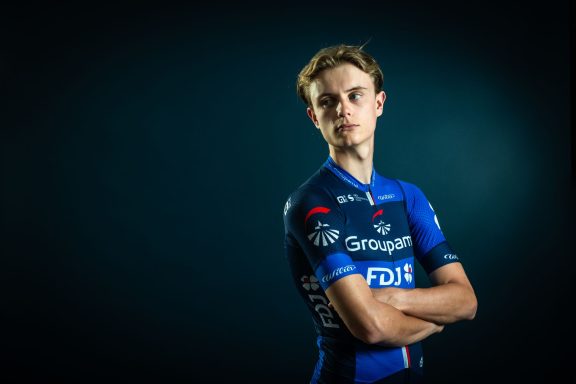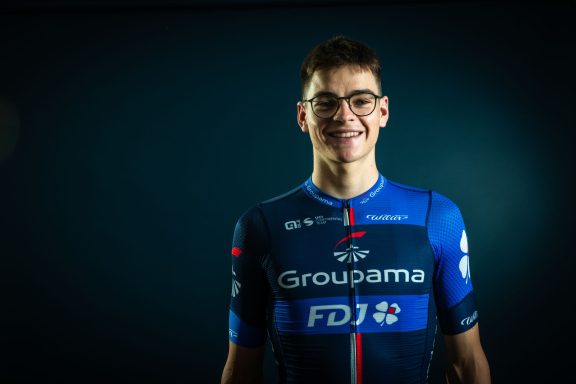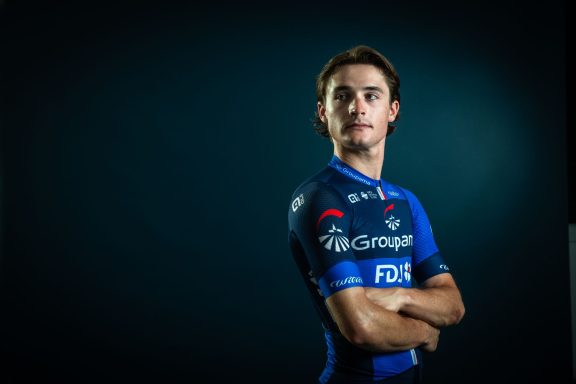Since the end of the lockdown in France, on May 11, all the riders of the Groupama-FDJ cycling team now have the opportunity to ride outdoors. With more than three months to go before the first planned races, an important preparation is now looming for everyone, despite very diverse experiences during the last two months. We took stock with the team’s performance director, Frédéric Grappe.
What was the physical condition of the riders after two months in lockdown?
The shape decreased, obviously, but it is not that simple. There is not always a direct connection between the athlete’s feelings and what reality says in terms of measurements. When the riders are well trained during the season and they happen to feel bad, they only lose 4-5% of their performance level. It’s not much, but they feel it. So obviously, if you have a drop of about 15-20%, for them it’s huge and they think they have lost everything. But it is actually not dramatic. They will quickly reassure themselves and notice that it comes back quickly enough. Let’s say that they’re so used to playing on very small fluctuations that if they suddenly go over 10%, they feel like they are back to square one. In truth, they haven’t lost that much. Everything is relative, and everything will quickly return to normal.
“We had to be very flexible”
Could endurance tests be put in place to know their actual state of shape?
We have planned some for early July. At that point, they will have done a month and a half of training already. Because it would be a very long time without races, it will be important to make an overall assessment of the troops’ condition, to get objective measurements of their physical potential. This will be done in due course and under conditions yet to be defined. It will be a real milestone, both for them and for us. You can’t let athletes get to the start of a race without giving them points of references. On the other hand, there is no point in doing it now. Our objectives are still very far. Doing tests at the end of a period when training was more about staying fit, it does not make much sense. Those we will practice later will need to give them confidence and let them know where they stand before the races. In addition, just saying that the condition has dropped by 10-15% is not clear; you must set the context. Finally, surely that as things stand, some guys would not even be able to do the test properly. You need to enjoy a favourable context and get a big motivation from the riders. We are in a phase where training is the watchword, even if the load remains low. It would be inappropriate to do some tests in this period, which is not suitable to that matter.
“Mental freshness” and “constraints-pleasure balance” were the key concepts of the two months of lockdown. Has the mission been fulfilled in that regard?
Clearly, everything went rather well for the forty-two riders of the team (WorldTeam and Conti combined). We didn’t have any complicated cases to deal with. On the other hand, the indoor sessions were very individualized and did not come from a ready-made ‘copy-paste’. Everything has been done according to the responses every one would give. Some raced, others did not because they did not want to. We didn’t force anyone. Constraint appears when you push too much, when you force someone to do something that he does not want to do. It did not happen. It was long, of course, but our riders handled it quite well. It also enabled some who didn’t like riding indoor to finally see the point of it. At times during the year, it can be interesting to do it. This helped to equalize the team with regard to this practice, and it will be useful for the future. Instead of going outside in bad weather, some will understand that it might be more interesting to do a good session indoor. Virtual platforms have also proven to be useful and effective. Everyone noticed it. Some already knew it, others learned to like it, and others did not enjoy it more than that. But generally speaking, I think that all of them, at one point, found some usefulness in that. For me, it’s also another way of training, a new stimulation lever. This period brought some positives things.
It appears that the riders seem to have enjoyed quite a freedom…
We had to be flexible. Not to be flexible in this period would have been a big mistake. We could have got some of them back kind of “upside down”. They would have gone outside, of course, but probably with a different momentum. The main watchword was understood. I also think that mapping out the major stages, giving them visibility over several weeks, even if there obviously were adjustments, was very important from this point of view. For example, we have already drawn a plan until January 31, 2021. This is a bit hypothetical, of course, but at least, they know from today on how everything will be shifted if everything goes as expected. It’s important to have a long-term vision. We don’t want just to be focused on 2020, which is a very very special year, but already to set in motion the 2021 organization and make it clear to the riders. It includes some ‘conditional’, but the main steps are mapped out and we will make the needed adjustments. Being able to anticipate the future is very important for the rider.
“Not to accumulate tiredness”
Have you already noticed differences between confined and non-confined riders?
We could notice them if, in 15 days, we would do a camp with riders who rode indoor and others who rode outdoor. We could see how the fatigue would spread over a week and how they would react to the different routes. Today, it’s more difficult to know. But you should know that even if some continued to ride on the road, the coaches have calmed them down a bit over the past two weeks so that they can restart at the same time than those who went out on May 11. Some therefore took a break of almost 15 days in early May. Besides, it was long for them too. Riding without a goal is complicated, even if you ride on the road. On the run of the races, some continued for some time just to have fun, but there comes a time when it becomes long and you lose pleasure as you ride without knowing why and without being able to look to a goal. At one point, they were going in circles. Riding without knowing why, it never happens to a top athlete. Anytime of the year, when he takes his bike out, he knows why he does so. It was a new situation for them. Some have been cycling since the age of 14-15 and had never experienced this.
Now that they’re all back on the road, what have they been advised to do?
We mapped out all the outlines until the racing restarts. The three weeks of May will be about endurance and the volume will increase from week to week, with one very important thing to keep in mind: not to accumulate tiredness. Getting to June with some fatigue shouldn’t happen. It is necessary to digest workloads and get the basics back. Coaches and riders understood this priority. For the first week, riding between 12 and 15 hours was well enough, for example. It’s going to be more and more, we’re going to introduce a few explosiveness sessions, a bit of technical work with standing up on the pedals and start the first heavy intensity loads in early June. All this will then take us to our expected tests in early July. Then, the July will be very specific depending on each rider’s racing program. Some will probably go to altitude for small training camps.
Is the preparation ultimately similar to that at the start of the season?
Not quite, because the “aquarium” is not the same. Working in November, December and January is completely different atmospherically wise. The riders will find themselves in a warm and temperate environment, which is much easier and comfortable. So, stimulations will be better, the body will respond much faster. So it will not be the same. This is also why we will have to be careful; we may have different responses. They will progress faster, due to the work accumulated since November – let’s not forget that -, but also due to the better weather conditions. From a methodological point of view, basics are quite similar, but the responses won’t be. Coaches will therefore have to make adjustments, which are not the same as in winter. The riders will quickly realize it.
“Recovery during races and at home will be essential”
How decisive will the relationship between the medical and the performance departments be in the coming months?
We work very closely and we are interlinked with each other. We have a lot of talks and we want to be very careful from a health point of view. We launched an internal questionnaire to make sure that the Covid-19 did not infect some riders, by highlighting potential symptoms. We insisted a lot that the riders let us know all of their feelings on a daily basis, on the team platform. They can quantify their sleep, their feelings during training, and their fatigue. The perceptible responses are essential in such a period. Even more than usual. This is what will guide the training for the coach and allow the doctor to detect if there are any points that need to be further explored. The only way we can be super-responsive is if the riders keep us well informed. They have everything it takes to do it and that’s very important. Depending on the questionnaires’ feedbacks and UCI protocols, there is also a possibility they undergo medical tests, but all this still needs to be refined.
Are you concerned about the gap that has been created between confined and non-confined riders?
Absolutely not! Three and a half months is more than enough. I’ve always said that in general, it takes twelve weeks to get a rider to the top when he starts from scratch. With good weather, with what they have already done before, there will be no problem. Gap will be filled and everything will be back in order as we go along, I’m not worried.
With only three months of racing, how do you get the riders to perform well immediately and lastingly?
They will not be at their top level right away. It is not possible when you arrive on your first race. This is unthinkable; it is necessary to make adjustments. But the whole peloton will be like that. Responses when training individually is one thing, those when competing with others are another. They will all get to the races like crazy, super motivated, and it will go all over the place. They will need to be able to analyse their responses well, as stimulations and efforts will not be the same. Some are able to interpret them fast enough and settle quickly, others need a bit more time to do so. We also know that they will spend their time between racing, going home and going back to the races. The training will be mainly a regulation and recovery training. It will not be used to make them improve; the races will be enough for that once the season resumes. Recovery during races and at home will be essential, and it will carry more weight than in other years. We have already drawn their attention to this specific point. Those who will be able to optimize their recovery will be those who will handle the three and a half months the best way. It is obvious, and it will make them progress for the following years. Our role is to enable them to access these tools – we have many on the team – and to be able to use them well.
“Instead of having three humps, we will only have one”
Is building up performance over such a short period a real challenge?
Obviously, since we never experienced it. We do not know what will happen, but in any case, there will not be a peak shape over three and a half months, this is not possible. It will rather be a curve like a dromedary’s hump, with different positions. Some will have the hump in the middle of the three months; others will have shifted it to the right, others to the left. Instead of having three humps in the year, as is often the case in a normal season, we will only have one. A rise, a descent, and a more or less long plateau atop.
But there will not be camel back, so two ‘humps’ in three months?
It might be too hard, I don’t believe in this method. I can possibly consider it but not with two real humps. Over three months, going up high, going down then going up high, it’s very hard; it’s too short really. We will have as many humps as riders eventually. You will need to target your goals extremely well. Again, we are a little bit unsure. We guess what can happen but it’s a leap into the unknown. When you do the Tour, you can keep your shape a week more, possibly 15 days. Then you go down and it’s normal. The level decreases. It may go up a bit again, but not as high or as long as it did in the first hump. Now, you have to be aware that in the rise of the curve you are good, above it you are very good, and in the descent you are still good. We have to put things in perspective: you are still good for a while. Ultimately, it doesn’t worry me. There will just be a pack of dromedaries wandering around and we will have to deal with it.



No comment